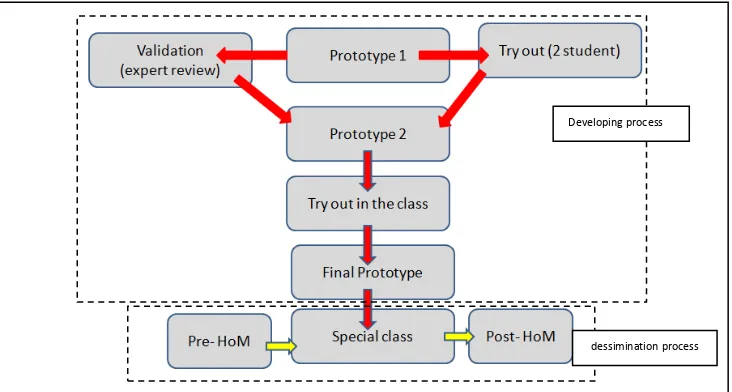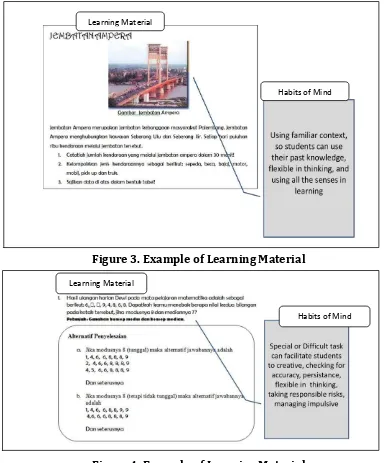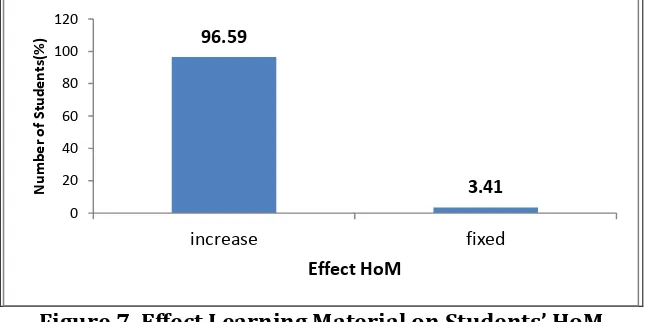LEARNING MATERIAL BASED ON REALISTIC MATHEMATICS EDUCATION CASE STUDY )N EN(ANC)NG STUDENTS’ MAT(EMAT)CAL (AB)TS OF M)ND
Ely Susanti1, Yaya S. Kusumah2
Sriwijaya University, Palembang1
Indonesian University of Education, Bandung2
Abstract
The background of this study is the lack of human resources. It can cause the low mathematical habits of mind and competitiveness of the Indonesian. Education and learning can identified as stategies that used to solve these problems. Because of that, this study aims to: (1) develop prototype learning material (LM) based on realistic mathematics education (RME); (2) produce a valid and practice prototype learning material based on RME; and (3) see the effect of LM on students’ mathematical habits of mind. This is a developmental research, that consists of: analyzing, designing, evaluating, and revising. The Instruments that used consist of documentation and questioner. Document is used to see a valid and practice of learning material. Questioner is used to see students’ mathematical habits of mind. The conclusion based on data analysis: (1) LM is developed in statistical topic for junior high school students; (2) LM prototype has been valid based on expert review and practice based on try out. (3) LM prototype is effective for students’ mathematical habits of mind.
Keywords: Developmental Research, Learning Material, Realistic Mathematics
Education, Mathematical Habits of Mind.
INTRODUCTION
Habits in the most simple sense is an activity or behavior that has been done a long time and become a part of life (Wikipedia, 2011). American Heritage Dictionary (1994) also defines a habit as a pattern of behavior that is shaped by continuous repetition. If a habit is done continously, it can be more powerful or settle on somebody, so it will be more difficult to change and it will entrenched in the individual self. From the above description, it can be concluded that a habit can be identified as a behavior or activity that grown up because of conducted continuously.
person to behave. Habits can also indicated a person's sensitivity and tendency to behave, therefore, the habit of mind broadly categorized into the following five dimensions, namely: values, behavior, ability, and commitment.
But, there are some facts that indicated that )ndonesian’s habits of mind still low. The
lack of human resources and competitiveness in Indonesia can be identified as the low
)ndonesian’s habits of mind. This problems may be caused by their habits and behavior
in learning during as student in primary school till university.
Cause of this problems, Indonesia currilum change their perspective in teaching and learning. In their perspective, teaching and learning process must be contained with active and creative activities, sharing idea, colaborative, contructivism, and special task (open-ended problems) now. This strategies not only choosen to increase thinking skills but also to enhance habits of mind.
One form of learning strategies that relevant to pedagogical theories is realistic mathematics education. RME approach can facilitate students to solve contextual problems in their own strategies and teachers should be as mentors, facilitators, or motivators for students when they have done exploration of ideas or discovery of a concept. Beside that, students’ contribution and colaboration in learning also as important point in this strategy.
Based on that idea, researcher interst to design a learning material that relevant to realistic mathematics education approach. Because of that, this study aims to:
1) Develop prototype learning material (LM) based on realistic mathematics education (RME)
2) Produce a valid and practice prototype learning material based on RME 3) See the effect of LM on students’ mathematical habits of mind.
LITERATURE REVIEW Habits of Mind
Habits in the most simple sense is an activity or behavior that has been done a long time and become a part of life (Wikipedia, 2011). A habit can grow if a behavior or activity that is conducted continuously. Based on the above concept, in general it can be concluded that the habit is a repeated presentation of a stimulus in behavior.
Habits are categorized into two , namely: in the habit of behaving (habituated) and in the habit of mind (thinking). Habits in behavior is the impact of the activity or motoric activity that is carried out repeatedly, whereas habit of mind is an activity that involves the impact of the thought process that also performed repeatedly. Habits of mind also can be interpreted as the brain synergizing behavior when doing something, both right brain and left brain. In other words, the habit of mind include synergizing intellectual and emotional behavior. Based on this concept, habit of mid is as habit of thinking that synergizing left and right brain. Right brain consist of cognitive, exact, supple, and silly. Left brain consist of control, understanding, and sensorial.
The following figures represent the seven dimensions and 16 aspects related to the habit of mind.
Figure 1. Habits of Mind
Realistic Mathematics Education
The philosophy of RME is mostly determined by Freudenthal's view on mathematics (cf. Freudenthal, 1991). Two view of his important points are: (1) mathematics must be connected to reality, and (2) mathematics should be seen as a human activity.
First, in order to start from reality that deals with phenomena that are familiar to the
students, Freudenthal’s didactical phenomenology, i.e. the view of learning as starting
contextual experience is used. Second, by the guided reinvention principle through progressive mathematizations, students are guided didactically and efficiently from one to another level of thinking. These two principles and the concept of self-developed models (Gravemeijer, 1994) are used as design principles both in developing the learning materials.
METHODOLOGY Participant
Participant in this study consist of three categories. They are participant in small group, large-scale, and dessimination. In this study, there are 2 students in small group, 28 students in large-scala, and 97 students in dessimination.
Design and Procedure of the study
The design used in this study is a Research and Development. This study not only focuses on the development of learning materials based on realistic mathematics education, but also to see its effect on students’ mathematical habits of mind. Because of that, in this consist of developing process and dessimination process. For dessimination process, the pretest-posttest design also used to see effect of learning material on
students’ M(oM. The following chart illustrates the steps to be performed in this study.
Figure 2. Procedure of Study
Instruments and Data Analysis
Document of learning material and validation sheets are instruments used in this study. Beside that, a questioner of MHoM also used to see effect of learning material on
students’ mathematical habits of mind.
To answer the statement of study, qualitative methods were used to analysis data from document of learning material and validation sheets. Beside that, pre-respons and post-respon from questioner also analyzed in descriptive qualitative.
FINDINGS OF THE STUDY Developing process
Before developing learning materials, researchers conducted a literature review. literature review was conducted in order to collect the learning theories that are relevant to realistic mathematics education and habits of students' mathematical thinking. The results of the literature review was used to develop learning material based on RME that related to mathematical habits of mind.
Based on literature review, learning material that will be developed must consist of difficult task, complex problem, but realistic. The adventage of this special task used to fasilitate students for colaboration, cooperation, discussion, negotiation, develop self
Developing process
model (informal and formal strategies), and develop students habits of mind. These are example of learning material that can enhance students habits of mind.
This stage consist of two phases, namely: paper-based and computer-based. Paper-based started with making sketch on the paper, and this result called as initial draft. Next, this initial draft is made in computer, and its result called as computer-based.
Validation and Try out Process
Validation of prototype 1
Validation phase (prototype 1). This stage is a continuation of phase previously. This stage aims to obtain a good LM based on content and construct. There are five expert that validate this LM. They are consist of lecture,mathematics teacher, and expert in language.This stage begins with a review of content and construct validity.
Content validity done by looking at the suitability of items were tested in accordance with the given subject matter, learning achievement indicators (topic: statistics), indicators of mathematical habits of mind, and the level of difficulty for the junior class IX students.
Construct validaty based on the clarity or legibility of text sentences, as well as the clarity or legibility of the pictures or illustrations used in the test item. The clarity or legibility in terms of language or editorial usage, presentation, and accuracy (accuracy) images or illustrations used.
Based on validation process, it can conclude that there are some revision: (1) select and use context that exist and close to the students (using familiar context); (2) learning material must facilitate student in thinking; 3 don’t use many hint in learning material; (4) let student thinking themselves; and (5) editorial usege.
Try out (Small Group)
This stage aims to look at the practicality of prototype 1 in the small group (two students). This stage is also used to strengthen the results of validation process. Based on try out in small group, research make some conclusion, such as: (1) students have some difficulties in unfamiliar context (population census), (2) making conclusion, (3) open-ended problems.
Revised Prototype 1
Revisions to the prototype 1 was conducted based on the suggestions of the validator and the results of the analysis of try out in small group. Following table represented revison based on validation and try out in small group.
Prototype 2
Prototype 2 is developed based on revisions of prototype. There are some modification in prototype 2, such as: contextual problem, editorial in language and display.
Try out (Large Scale)
This stage also aims to look at the practicality of prototype 2 in large scale (more than 20 students). This stage is also used to see students’ difficulties when solving problem in learning material. Based on try out in large scale, research make some conclusion, such as: (1) with familiar context, students can understand and solve problems; (2) if this learning material done him/her self, some students still have difficulties in making conclusion and solving open-ended problems.
Revised Prototype 2
In this section, revisions used to get final prototype. Based on try out in large scale, following figures represented example of learning material.
Figure 3. Example of Learning Material
Figure 4. Example of Learning Material
Learning Material
Habits of Mind
Learning Material
Figure 5. Example of Learning Material
Learning Process
Learning process can not be done in haste, because the ultimate goal is students understand the learning material. In addition , the process of the invention concept or contextual problem solving in the classroom is much more utilizing simple media, such as: paper, nuts, candy, or stick. this learning process also causes the time required to complete the learning becomes longer than the planned time.
In classroom activities, PMR is also dominated by high- ability students, for example discussion in small group and class discussions. One of the causes of the low-ability students tend to be insecure and less confident in conveying their idea, and sometimes tend to be afraid of in expressing ideas that they have. At each meeting , the teacher always monitor and motivate low-ability students, as well as continue to provide the opportunity for them to be actively involved the learning, both in class discussions and group discussions.
The core of the learning process is horizontally and vertically matematisasi. Matematisasi horizontal and vertical processes in the classroom PMR done by using simple objects such as candy, nuts, cups of mineral water, and paper . Atmosphere in the classroom can be seen in Figure 4.2 below.
Figure 6. Dessimination
Dessimination
Dessimination process is aim to see effect of learning material on students’ Learning Material
learning process. Based on data analysis, it can be concluded: there are 96,59% students have enhancing in their mathematical habits of mind. Following figure represented result of dessimination process.
Figure 7. Effect Learning Material on Students’ (oM
Through these development process, learning material based on realistic mathematics education had categorized as valid and practical. Beside that, this learning material also have effect on students' mathematical habits of mind.
CONCLUSION
Based on data analysis,
(1) LM is developed in statistical topic for junior high school students;
(2) LM prototype has been valid based on expert review and practice based on try out. (3) LM prototype is effective for students’ mathematical habits of mind.
REFERENCES
Costa, A. (1996). Developing Minds: A Resource Book for Teaching Thinking. Virginia: ASCD.
Costa, A dan Kallick. (2010). Learning and Leading with Habits of Mind. Virginia: ASCD.
Cuoco. (1997). Habits of Mind: An Organizing Principle for Mathematics Curriculum.
[Online]. [20 Mei 2011].
Davenport, B. (2012). How to Create Habits that Stick. [Online]. [20 Agustus 2013].
Dean, J. (2012). Birth of a Habit. [Online]. [20 Agustus 2013].
Dobson. (2009). It Takes 66 Days to Form a Habit. [Online]. [20 Oktober 2013]
Gravemeijer, K.P.E. (1994). Developing Realistic Mathematics Education. Utrecht: Freudenthal Institute.
Irawati, S. (2010). Habits of Mind. [Online]. [10 Januari 2012].
Lim. (2009). Mathematical Habits of Mind. [Online]. [20 Mei 2011].
Maxwell, K. (2001). Positive Learning Dispositions in Mathematic. [Online]. [20 Mei 2013]
Marzano, R.J. et al. (1988). Dimensions of Thinking: A Framework for Curriculum and Instruction. Virginia: ASCD
Marzano, R. J. et al. (1997) Dimension of Learning Trainer’s Manual. Colorado: McREL
Millman, R. S. dan Jacobbe. (2008). Fostering Creativity In Preservice Teachers Through Mathematical Habits of Mind. Proceeding of the Discussing Group 9. The 11th
International Congress on Mathematical Education. [Online]. [12 Mei 2011]
Naeve. (2004). ICT Enhanced Mathematics Education. International Journal of Learning Technology, 1(3).
PISA. (2009). PISA 2009 Result: What Student Know and Can Do Student Performance in Reading,Mathematics, and Science. OECD
Sabandar, J. (2010). Thinking Classroom dalam Pembelajaran Matematika di Sekolah. [Online]. [20 Januari 2013].
Selvia. (2012). Landasan dan Keunggulan PMRI dalam Matematika. [Online]. [20 Januari 2013].
Sen, V. (2012). What are the Advantages and Disadvantages of Computer-Assisted Learning?. [Online]. [23 Oktober 2013]
Shafer, M. C., dan Foster, S. (1997). The Changing Face of Assessment. [Online]. [23 Oktober 2013]
Shepard, L. A. (1989). Why We Need Better Assessment. Educational Leadership, 46(7), pp. 4-9
Slavin, R. E. (1995). A Model of Effective Instruction. The Educational Forum, 59, pp. 166-176
Smith, R. (2003). Learning in Virtual Teams: A Summary of Current Literature. [Online]. [23 Oktober 2012]
Sudjana, N. (2012). Penilaian Hasil Proses Belajar Mengajar. Bandung: PT Remaja Rosdakarya.
Sudjana, N dan Rivai.(2002). Media Pengajaran. Bandung: Sinar Baru Algesindo
Sudrajat, A. (2009). Kesalahan Siswa dalam Menyelesaikan Soal Matematika. [Online]. [23 Oktober 2010]
Sugiman. (2010). Dampak Pembelajaran Matematika Realistik terhadap Peningkatan Kemampuan Pemecahan Masalah dan Keyakinan Matematik Siswa Sekolah
Menengah Pertama di Kota Yogyakarta. (Disertasi). Sekolah Pascasarjana,
Universitas Pendidikan Indonesia, Bandung.
Sugiyono. 2010. Metode Penelitian Kuantitatif Kualitatif dan R&D. Bandung: Alfabeta
Somakim. (2010). Peningkatan Kemampuan Berpikir Kritis Dan Self Efficacy Matematika Siswa Sekolah Menengah Pertama Dengan Penggunaan Pendekatan Matematika Realistik. (Disertasi). Sekolah Pascasarjana, Universitas Pendidikan Indonesia, Bandung.
Suherman, E. (2001). Common Textbook: Strategi Pembelajaran Matematika
Kontemporer. Bandung: JICA-Universitas Pendidikan Indonesia.
Suryadi, D. (2012). Membangun Budaya Baru dalam Berpikir Matematika. Bandung: Rizqi Press.
Stacey, K. (2011). The PISA View of Mathematical Literacy in Indonesia. Indoms: Journal Mathematics Education, 2(2), pp. 95-126.
Studynet. (2013). What is Computer Aided Learning (CAL). [Online]. [27 Juni 2013].
Sternberg. (2006). The Essential Sternberg: Essays on Intelligence, Psychology, and Education. [Online]. [27 Juni 2013].
Susanti, E. (2012). Profil Higher Order Thinking Skills Dan Mathematical Habits Of Mind Siswa: Studi Kasus Pada Siswa Sekolah Menengah Atas Untuk Topik Statistika.
Forum MIPA,15(2), pp. 120-127.
Sutrisno. (2011). Pengantar Pembelajaran Inovatif berbasis Teknologi Informasi dan Komunikasi. Jakarta: Gaung Persada Press.
Syahputra, E. (2011). Peningkatan Kemampuan Spasial Dan Disposisi Matematis Siswa
Smp Dengan Pendekatan Pmri Pada Pembelajaran Geometri Berbantuan Komputer.
(Disertasi). Sekolah Pascasarjana, Universitas Pendidikan Indonesia, Bandung.
Tandililing, E. (2012) Implementasi Realistic Mathematics Education di Sekolah. [Online]. [20 Januari 2014]
Thomas, A. dan Thorne, G. (2009). Higher-Order Thinking. [Online]. [10 Oktober 2013].
Thompson, T. (2000). Analysis of Higher-Order Thinking 1: An Analysis of Higher-Order Thinking on Algebra I End-of Couse Test. [Online]. [10 Januari 2013]
Uzel. (2006). Attitudes of 7th Classstudents toward Mathematics in Realistic Mathematics Education. International Mathematical Forum,39(1), pp. 1951-1959.
Uyanto, S. (2009). Pedoman Analisis Data dengan SPSS. Yogyakarta: Graha Ilmu
Varank. (2006). A Comparison of a Computer-Based and a Lecture-Based Computer Literacy Course: a Turkish Case. Eurasia Journal of Mathematics, Science and Technology Education,2(3), pp. 43-47.
Widdiharto, R. (2008). Diagnosa Kesulitan Belajar Matematika SMP dan Alternatif Proses
Remidinya. Yogyakarta: P4TK Matematika.
Wegerif, R. (2002).Thinking Skills, Technology and Learning. . [Online]. [20 Januari 2012]
Wikipedia. (2011). Habit. [Online]. [20 Januari 2013]
Wiwatanapataphee, et al. (2010). An Integrated Powerpoint-Maple Based Teaching-Learning Model for Multivariate Integral Calculus. IΣJMΣ: International Electronic
Journal of Mathematics Education. 5(1), pp. 5-31.
Yushau. (2006). Computer Attitude, Use, Experience, Software Familiarity an Perceived Pedagogical Usefulness: The Case of Mathematics Professors. Eurasia Journal of Mathematics, Science and Technology Education, 2(3), pp.1-7.
Zulkardi. (2005). Pendidikan Matematika Di Indonesia: Beberapa Perrmalasahan dan Upaya Penyelesaian. Pidato Pengukuhan Sebagai Guru Besar Tetap Dalam Bidang Ilmu Pendidikan Matematika Pada Fkip Unsri. Palembang: Universitas Sriwijaya.
Zulkardi. (2010). How to Design Mathematics Lessons Based on The Realistic Approach?.




